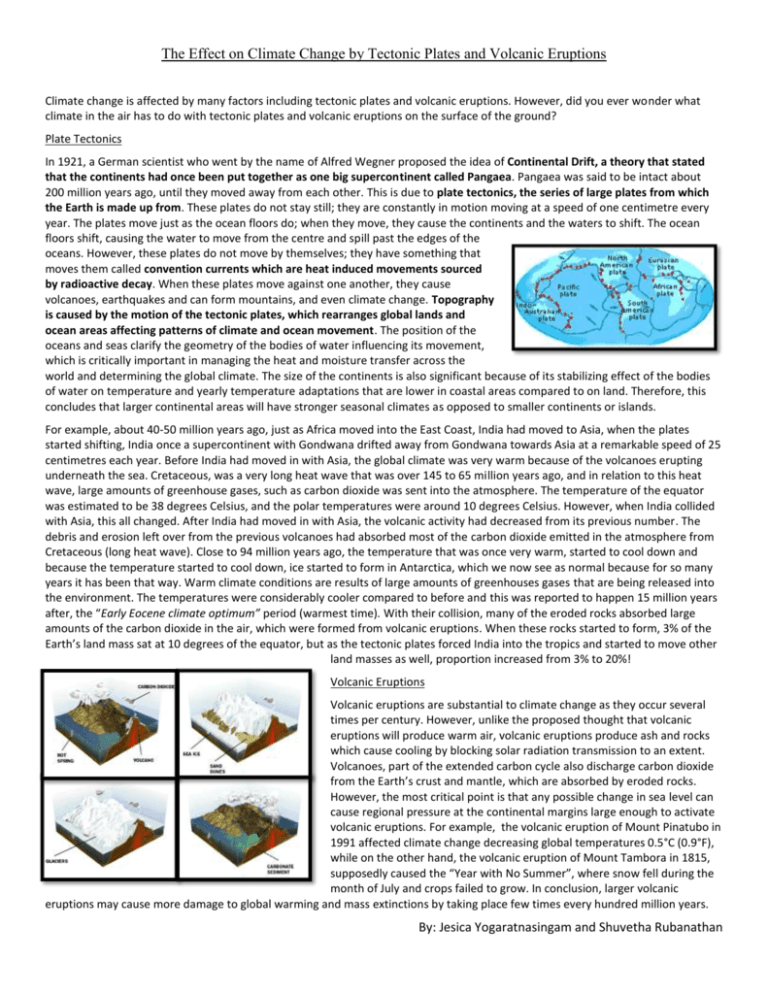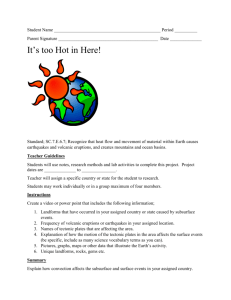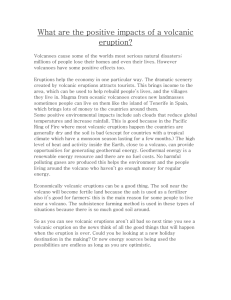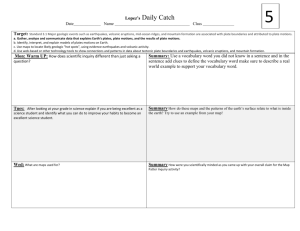The Effect on Climate Change by Tectonic Plates and Volcanic
advertisement

The Effect on Climate Change by Tectonic Plates and Volcanic Eruptions Climate change is affected by many factors including tectonic plates and volcanic eruptions. However, did you ever wonder what climate in the air has to do with tectonic plates and volcanic eruptions on the surface of the ground? Plate Tectonics In 1921, a German scientist who went by the name of Alfred Wegner proposed the idea of Continental Drift, a theory that stated that the continents had once been put together as one big supercontinent called Pangaea. Pangaea was said to be intact about 200 million years ago, until they moved away from each other. This is due to plate tectonics, the series of large plates from which the Earth is made up from. These plates do not stay still; they are constantly in motion moving at a speed of one centimetre every year. The plates move just as the ocean floors do; when they move, they cause the continents and the waters to shift. The ocean floors shift, causing the water to move from the centre and spill past the edges of the oceans. However, these plates do not move by themselves; they have something that moves them called convention currents which are heat induced movements sourced by radioactive decay. When these plates move against one another, they cause volcanoes, earthquakes and can form mountains, and even climate change. Topography is caused by the motion of the tectonic plates, which rearranges global lands and ocean areas affecting patterns of climate and ocean movement. The position of the oceans and seas clarify the geometry of the bodies of water influencing its movement, which is critically important in managing the heat and moisture transfer across the world and determining the global climate. The size of the continents is also significant because of its stabilizing effect of the bodies of water on temperature and yearly temperature adaptations that are lower in coastal areas compared to on land. Therefore, this concludes that larger continental areas will have stronger seasonal climates as opposed to smaller continents or islands. For example, about 40-50 million years ago, just as Africa moved into the East Coast, India had moved to Asia, when the plates started shifting, India once a supercontinent with Gondwana drifted away from Gondwana towards Asia at a remarkable speed of 25 centimetres each year. Before India had moved in with Asia, the global climate was very warm because of the volcanoes erupting underneath the sea. Cretaceous, was a very long heat wave that was over 145 to 65 million years ago, and in relation to this heat wave, large amounts of greenhouse gases, such as carbon dioxide was sent into the atmosphere. The temperature of the equator was estimated to be 38 degrees Celsius, and the polar temperatures were around 10 degrees Celsius. However, when India collided with Asia, this all changed. After India had moved in with Asia, the volcanic activity had decreased from its previous number. The debris and erosion left over from the previous volcanoes had absorbed most of the carbon dioxide emitted in the atmosphere from Cretaceous (long heat wave). Close to 94 million years ago, the temperature that was once very warm, started to cool down and because the temperature started to cool down, ice started to form in Antarctica, which we now see as normal because for so many years it has been that way. Warm climate conditions are results of large amounts of greenhouses gases that are being released into the environment. The temperatures were considerably cooler compared to before and this was reported to happen 15 million years after, the “Early Eocene climate optimum” period (warmest time). With their collision, many of the eroded rocks absorbed large amounts of the carbon dioxide in the air, which were formed from volcanic eruptions. When these rocks started to form, 3% of the Earth’s land mass sat at 10 degrees of the equator, but as the tectonic plates forced India into the tropics and started to move other land masses as well, proportion increased from 3% to 20%! Volcanic Eruptions Volcanic eruptions are substantial to climate change as they occur several times per century. However, unlike the proposed thought that volcanic eruptions will produce warm air, volcanic eruptions produce ash and rocks which cause cooling by blocking solar radiation transmission to an extent. Volcanoes, part of the extended carbon cycle also discharge carbon dioxide from the Earth’s crust and mantle, which are absorbed by eroded rocks. However, the most critical point is that any possible change in sea level can cause regional pressure at the continental margins large enough to activate volcanic eruptions. For example, the volcanic eruption of Mount Pinatubo in 1991 affected climate change decreasing global temperatures 0.5°C (0.9°F), while on the other hand, the volcanic eruption of Mount Tambora in 1815, supposedly caused the “Year with No Summer”, where snow fell during the month of July and crops failed to grow. In conclusion, larger volcanic eruptions may cause more damage to global warming and mass extinctions by taking place few times every hundred million years. By: Jesica Yogaratnasingam and Shuvetha Rubanathan The Affect on Climate Change by Tectonic Plates and Volcanic Eruptions Assessment 1. Where did the theory of plate tectonics come from? Who came up with this theory? ____________________________________________________________________________________ ____________________________________________________________________________________ ____________________________________________________________________________________ 2. When describing the changes to climate, which two continents could you use as an example? ____________________________________________________________________________________ ____________________________________________________________________________________ ____________________________________________________________________________________ 3. Describe the climate changes before plate tectonics and after? ____________________________________________________________________________________ ____________________________________________________________________________________ ____________________________________________________________________________________ ____________________________________________________________________________________ 4. What was the name of the warmest period in history and what was it like? ____________________________________________________________________________________ ____________________________________________________________________________________ ____________________________________________________________________________________ 5. Explain how topography and the size of continents are significant to climate change? ____________________________________________________________________________________ ____________________________________________________________________________________ ____________________________________________________________________________________ 6. Describe how volcanic eruptions play its part in climate change? Use examples to support your answer. ____________________________________________________________________________________ ____________________________________________________________________________________ ____________________________________________________________________________________ ____________________________________________________________________________________ ____________________________________________________________________________________ 7. How do carbon dioxide and greenhouse gases play an important role in climate change? ____________________________________________________________________________________ ____________________________________________________________________________________ ____________________________________________________________________________________ 8. How do volcanic eruptions and plate tectonics relate to each other? ____________________________________________________________________________________ ____________________________________________________________________________________ ____________________________________________________________________________________ ____________________________________________________________________________________








